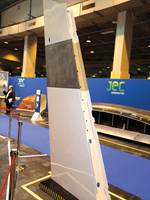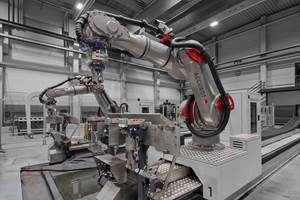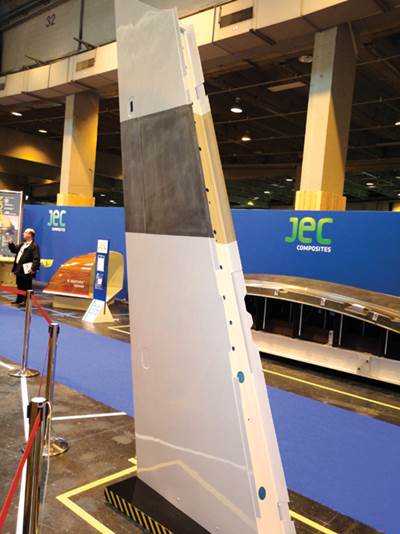No dark clouds at JEC
Icelandic ash aside, there were no dark clouds over the JEC show floor as the 2010 event proved to be a pleasant surprise.
If you’d told me on April 11, when I arrived in Paris for the JEC Composites Show, that eight days later I would be racing south to escape an ash cloud from an Icelandic volcano with a nigh unpronounceable name (Eyjafjallajokull) that had shut down most European airspace, I’d have thought you a loon.
But here I sit, April 20, typing these words on a train somewhere in Spain, hoping to catch a flight to the U.S. in Madrid from one of the few functioning airports within 1,000 miles. I am not alone. I’m traveling with four colleagues and hundreds of other composites industry professionals who, like me, found themselves stranded on the show’s last day.
Prior to the collapse of European air travel, however, the 2010 JEC event had already established itself as one of the most remarkable in recent memory even without Iceland’s help. No dark clouds there. Almost every exhibitor I spoke with was pleasantly surprised by activity at the show, with some going so far as to “complain” at being overwhelmed at times — a good problem to have in a recovering economy. The energy on the floor seemed, on the whole, very positive.
But we journalists tend to look for more tangible signals in a recovering economy that things really are getting better — that the industry is pushing ahead with product design and development. HPC saw such signs on the JEC show floor. Among the most newsworthy was the presence of SGL Automotive Carbon Fibers, the new company whose decision, April 6, to site a carbon fiber production plant in Moses Lake, Wash., set the groundwork for a vertical supply chain that will provide 50K fiber for BMW’s all-electric Megacity urban commuter car. HPC technical editor Sara Black and I had an opportunity to sit down at the JEC show and speak with Andreas Wüllner and Jörg Pohlman, both managing directors at the new firm, which is a joint venture of SGL Group and automaker BMW. This interview is spotlighted in our “JEC Composites Show Highlights” report, under "Editor's Picks," at right), but the upshot is that BMW apparently has developed a resin transfer molding (RTM)-based out-of-autoclave manufacturing process that will enable quick production of a carbon fiber-reinforced composite chassis for the Megacity, minimizing its weight and, thus, maximizing its energy economy. And contributing less to that unseen cloud of greenhouse gases.
Although this manufacturing effort deserves to be watched closely, it raises intriguing questions: How fast is this RTM process? What will be the price point of the Megacity? More importantly, will the car be within reach of the average urban-commuting consumer? Is this the process that will finally enable use of carbon fiber in production cars and trucks? Does it signal the start of widespread carbon fiber use in the automotive industry, like the Boeing 787 and Airbus A380 have in the aerospace sector?
None of these questions can be answered right now. As our brief report in this issue underscores, the future is still obscured by clouds of uncertainty. But, we do know that BMW would not have taken such a leap of faith — not to mention placing, with SGL, such a very large multimillion dollar bet — were it not confident that it had a workable manufacturing process and favorable odds of success. It’s certainly possible that the Megacity, due to make its debut before 2015, will mark a new applications milestone in the maturing composite materials-and-processes community.
We'll keep an eye on those clouds — no matter where we are — looking for tangible signs that this and other evolving technologies will get us to our destination.
Related Content
Development of a composite liquid hydrogen tank for commercial aircraft
Netherlands consortium advances cryogenic composites testing, tank designs and manufacturing including AFP, hybrid winding, welding of tank components and integrated SHM and H2 sensors for demonstrators in 2025.
Read MoreThe potential for thermoplastic composite nacelles
Collins Aerospace draws on global team, decades of experience to demonstrate large, curved AFP and welded structures for the next generation of aircraft.
Read MoreAutomated robotic NDT enhances capabilities for composites
Kineco Kaman Composites India uses a bespoke Fill Accubot ultrasonic testing system to boost inspection efficiency and productivity.
Read MoreLow-cost, efficient CFRP anisogrid lattice structures
CIRA uses patented parallel winding, dry fiber, silicone tooling and resin infusion to cut labor for lightweight, heavily loaded space applications.
Read MoreRead Next
JEC Composites Show 2010 Highlights
Despite the volcanic ash that clouded air travel, an eruption of new technology and new business did much to dispel the clouds of economic recession.
Read MoreNext-gen fan blades: Hybrid twin RTM, printed sensors, laser shock disassembly
MORPHO project demonstrates blade with 20% faster RTM cure cycle, uses AI-based monitoring for improved maintenance/life cycle management and proves laser shock disassembly for recycling.
Read MoreScaling up, optimizing the flax fiber composite camper
Greenlander’s Sherpa RV cab, which is largely constructed from flax fiber/bio-epoxy sandwich panels, nears commercial production readiness and next-generation scale-up.
Read More












